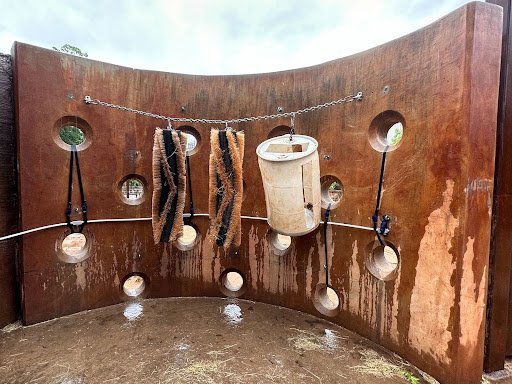How Zoo Atlanta’s Elephants Are Experimenting with Sound
Image: Ben Mayo
Inside the Technology Square Research Building (TSRB) in Tech Square, impressive work is being done to improve the lives of animals with interactive technology. At the heart of this work is PhD student Arianna Mastali, whose research in animal-centered computing focuses on designing wearable computers and interactive enrichment devices. With a background in computer engineering and human-computer interaction, Mastali's interdisciplinary expertise has culminated in a unique project to enrich the lives of the elephants at Zoo Atlanta.
The Challenge: Enriching Elephant Lives
African elephants (Loxodonta africana) are intelligent, social creatures that require complex environments to stay mentally and physically stimulated. Zoo Atlanta already provides various enrichment tools for its elephants, including food-based activities. However, Mastali and her colleagues saw an opportunity to explore new enrichment methods using sound, which remains relatively untapped in animal-centered research.
"Can we create a meaningful interaction for these elephants that goes beyond food and engages their curiosity in new ways?" Mastali asks.
The Elephant Enrichment Device
In August 2023, Mastali joined forces with fellow researchers Benjamin Mayo, Charles Ramey, Professor Melody Jackson, and elephant keepers Nate Elgart and Kirby Miller to design and implement an audio enrichment device for Zoo Atlanta's elephants. Mastali led the project's firmware development and research efforts, designing a robust device capable of withstanding the elephants’ strength.
The result was an interactive wall outfitted with sensors embedded in four holes. The sensors detected movement when an elephant inserted its trunk into one of the holes. Each hole played a corresponding low-frequency sound — a range well-suited to elephants, who communicate using infrasound.
“We wanted the elephants to control their environment,” Mastali explains. “By enabling them to trigger sounds independently, we could tap into their natural curiosity and give them an additional enrichment layer.”
Measuring Impact
The team conducted a week-long study comparing the wall's usage before and after the audio feature was added to gauge the device's success. Video footage captured the elephants’ behavior, and data from the sensors tracked the frequency and duration of wall interactions.
The results were striking:
The male elephant increased his interaction time from 4.5 to 6.5 hours.
One female elephant went from 6.5 hours to 11 hours of interaction time.
Another female increased her interaction time from 1 to 3 hours.
Overall, the frequency of wall usage increased by 81 instances, and the elephants spent an additional 3 hours, 28 minutes, and 23 seconds engaging with the enrichment tool.
“These results suggest that the elephants were not only intrigued by the sound but also enjoyed it,” Mastali says. “Their increased interaction could be attributed to curiosity, or perhaps they found the sounds pleasing.”
Challenges and Next Steps
Building a device sturdy enough to endure the elephants’ interactions was no small feat. "Elephants are powerful and tend to test anything new in their environment,” Mastali explains. This necessitated multiple design iterations to ensure the wall could withstand daily use.
Another challenge was sensor accuracy. While the device successfully collected data with an 88.14% accuracy rate, false activations remained an issue. To address this, the team is now transitioning from sensors installed on the wall to a computer vision system. Cameras will detect motion and trigger the tones, eliminating the physical vulnerabilities of wires in the elephants' space.
“This upgrade will allow us to collect data over longer periods and gain deeper insights into the elephants’ interactions,” Mastali notes.
The Broader Vision
Mastali sees this project as just the beginning. Inspired by the success of the audio enrichment device, she hopes to expand the work to other animals at the zoo, tailoring enrichment devices to their specific behaviors and needs.
“This project highlights how technology can bridge the gap between human and animal worlds,” she says. “By understanding and enhancing the lives of these incredible creatures, we not only improve their welfare but also deepen our appreciation for them.”
Her work, which combines engineering, human-computer interaction, and animal behavior studies, is making waves within the growing animal-centered computing field. It reminds us how interdisciplinary approaches can lead to scientific collaborations and breakthroughs.
For Mastali, the ultimate reward is seeing the elephants thrive. “Watching them engage with something we built is incredible.”





